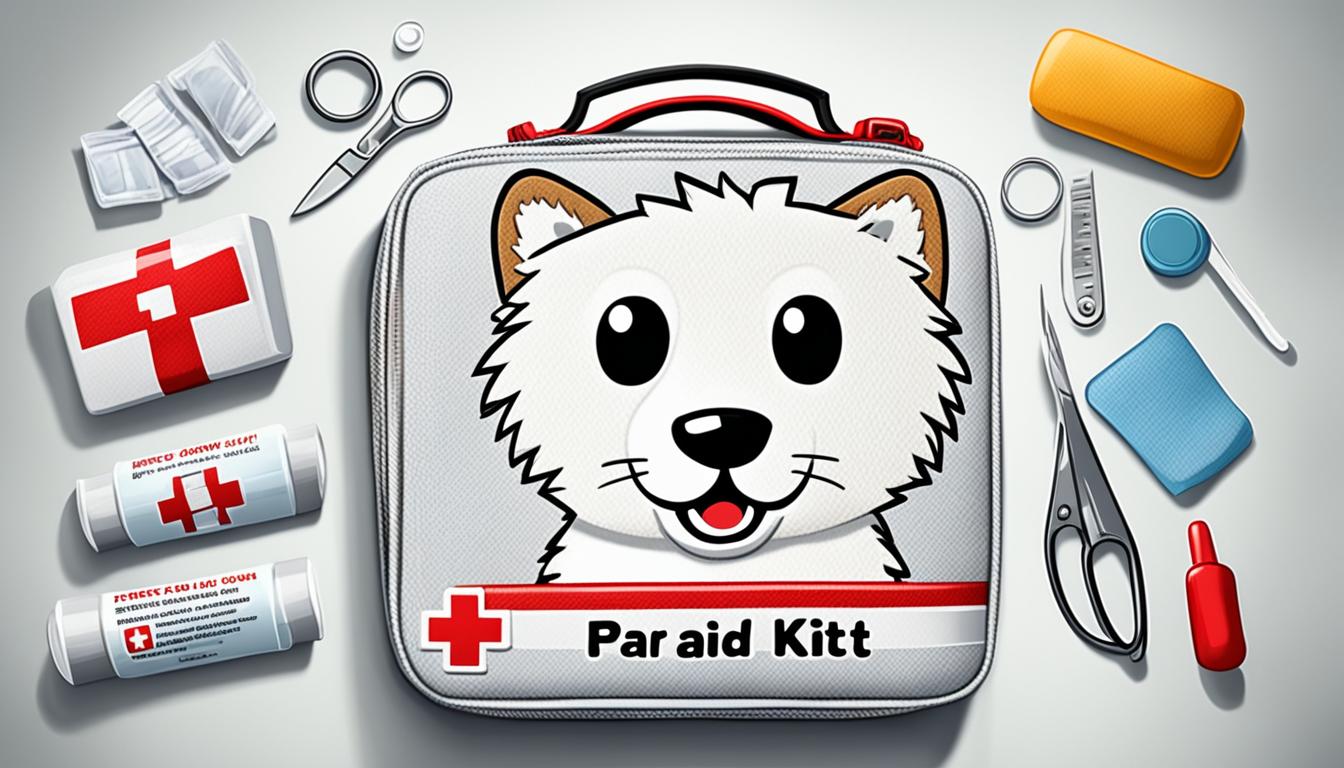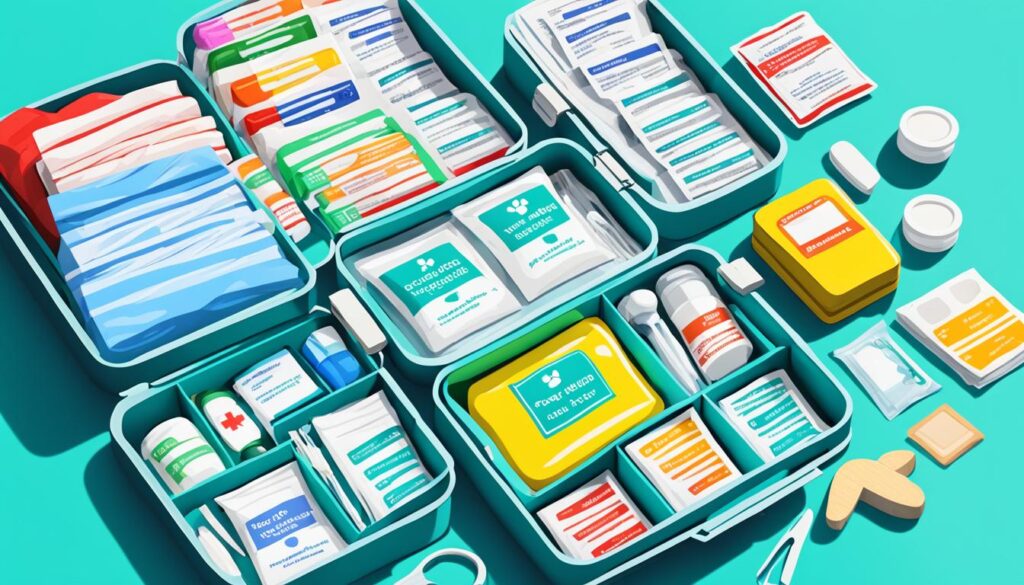Furry First Aid: Handling Emergencies

Did you know that over 50% of pet owners will experience a pet emergency at some point in their furry friend’s life? Whether it’s a sudden illness or an unexpected injury, being prepared and knowing how to handle these situations is essential for pet owners.
Being prepared for pet emergencies means having the knowledge and resources to keep your pet safe and provide the necessary first aid until professional help is available. From recognizing the signs of a pet emergency to creating a pet first aid kit, this guide will equip you with the essential tools and techniques to handle emergencies and ensure your pet’s well-being.
Key Takeaways:
- Over 50% of pet owners will experience a pet emergency in their pet’s lifetime.
- Being prepared and knowing how to handle emergencies is crucial for pet owners.
- Recognizing the signs of a pet emergency and creating a pet first aid kit are essential steps in being prepared.
- Learning basic first aid techniques for pets and knowing when to seek professional help can make a difference in a life-threatening situation.
- Preventing pet emergencies through preventive measures and regular veterinary care is the best approach to keeping your pet safe and healthy.
Recognizing Signs of a Pet Emergency
It’s vital to be able to recognize the signs of a pet emergency in order to act quickly and get your pet the help they need. Some common symptoms of a pet emergency include difficulty breathing, seizures, sudden loss of consciousness, severe bleeding, and choking. If you notice any of these signs, it is important to seek immediate veterinary care.
Pets are vulnerable to various emergencies and can experience sudden health issues that require prompt attention. Difficulty breathing may indicate respiratory distress or airway obstruction. Seizures may be a sign of neurological problems or underlying conditions, such as epilepsy. Sudden loss of consciousness could be a result of organ failure or serious injuries. Severe bleeding may occur due to trauma or internal injury. Choking poses a threat to your pet’s airway and can be life-threatening if not resolved immediately.
“Recognizing signs of a pet emergency is essential for pet owners. It allows them to respond swiftly and appropriately, potentially saving their pet’s life,” says Dr. Emily Anderson, a renowned veterinarian.
When you notice any of these signs, it’s crucial not to wait and see if the situation improves on its own. Acting quickly can significantly increase the chances of a positive outcome. Contact your veterinarian or an emergency veterinary clinic right away for guidance and instructions on how to proceed. They can assess the situation and advise you on the necessary actions to take.
Remember, early intervention and professional care are essential in pet emergencies. Delaying treatment can have severe consequences and jeopardize your pet’s health and well-being.
| Signs of a Pet Emergency | Actions to Take |
|---|---|
| Difficulty breathing | Seek immediate veterinary care |
| Seizures | Contact your veterinarian or an emergency veterinary clinic for guidance |
| Sudden loss of consciousness | Notify your veterinarian or take your pet to an emergency clinic immediately |
| Severe bleeding | Apply direct pressure to stop the bleeding and transport your pet to a veterinary facility |
| Choking | Perform the Heimlich maneuver if possible and seek immediate veterinary care |
Being able to recognize the signs of a pet emergency and taking swift action can make a significant difference in your pet’s outcome. Stay vigilant and familiarize yourself with these symptoms to ensure the well-being of your furry friend.
Creating a Pet First Aid Kit
When it comes to handling a pet emergency, having a well-stocked pet first aid kit is an essential preparation. This kit should contain all the necessary supplies to quickly and effectively provide initial care to your furry friend. Whether you are at home or on the go, having these essential items readily available can make all the difference.
Gather the Essential Supplies
Here are the key supplies to include in your pet first aid kit:
- Gauze: This versatile material is ideal for dressing wounds and controlling bleeding.
- Bandages: Choose bandages that are self-adhesive and suitable for pets, allowing you to secure dressings in place.
- Antiseptic wipes: These wipes are crucial for cleaning wounds and preventing infection.
- Tweezers: Having a pair of tweezers on hand can help you remove splinters or ticks safely.
- Medications: Include any necessary medications specific to your pet’s needs, such as anti-inflammatory medication or allergy medication.
Additionally, consider including a pet thermometer, hydrogen peroxide (for inducing vomiting if instructed by a veterinarian), and a pet first aid manual for reference.
Organize and Store the Kit
Keep your pet first aid kit in a durable container that is easily accessible to everyone in your household. Make sure the container is labeled clearly and kept in a consistent location, so it can be quickly located during emergencies. This will save you precious time when every second counts.
Remember to check and replenish your supplies regularly to ensure that everything is up-to-date and in good working condition. Discard any expired medications or supplies to maintain the efficacy of the kit.

Learning Basic First Aid Techniques for Pets
Knowing basic first aid techniques for pets is essential in handling emergencies. By learning these techniques, you can provide immediate care to your furry friend and potentially save their life. Here are some important pet first aid techniques to know:
- CPR: CPR (Cardiopulmonary Resuscitation) is a lifesaving technique that can be performed on pets in cardiac arrest. It involves chest compressions and rescue breaths to restore blood circulation and oxygenation. Proper training and technique are crucial for performing CPR effectively.
- Stop bleeding: In the event of an injury with severe bleeding, it’s important to know how to control the bleeding. Applying direct pressure using sterile gauze or a clean cloth can help stop the bleeding. Elevating the injured limb, if possible, can also aid in reducing blood flow to the area.
- Treat burns: Burns can be caused by various factors, including hot surfaces, chemicals, or flames. If your pet sustains a burn, it’s essential to cool the affected area with cool (not cold) water and seek veterinary attention. Avoid applying any ointments or creams without professional guidance.
- Handle choking: Choking is a potentially life-threatening situation that requires immediate action. If your pet is choking and unable to breathe, you can attempt to remove the obstruction by performing the Heimlich maneuver. However, it’s crucial to be cautious and seek veterinary assistance as soon as possible.
- Recognize the signs of heat stroke: Heat stroke is a serious condition that can occur in pets, especially during hot weather. Knowing the signs, such as excessive panting, drooling, collapse, or seizures, can help you recognize and respond to heat stroke promptly. Immediate cooling and veterinary care are crucial in these situations.
Consider taking a pet first aid course or consulting with your veterinarian to learn these techniques in detail. Remember, in an emergency, every second counts, and your knowledge and quick action can make a significant difference in your pet’s outcome.
Seeking Professional Help in Emergencies
While knowing basic first aid techniques is important for handling pet emergencies, there are situations where professional help is necessary. It is crucial to recognize serious or life-threatening emergencies and seek immediate veterinary care. Some scenarios that require professional assistance include difficulty breathing, seizures, and severe bleeding.
If your pet is having difficulty breathing, it could indicate a serious underlying condition such as an allergic reaction or respiratory infection. In such cases, it is essential to consult a veterinarian to determine the cause and provide appropriate treatment.
Seizures in pets can be caused by various factors, including epilepsy, poisoning, or neurological disorders. Professional help is crucial in identifying the cause of the seizures and developing a treatment plan to manage the condition effectively.
Severe bleeding can occur due to injuries, lacerations, or other internal complications. It is vital to seek immediate veterinary care to control the bleeding, prevent further complications, and provide necessary treatment.
When to Seek Professional Help:
- Difficulty breathing
- Seizures
- Severe bleeding
If you are unsure how to handle a situation or if your pet shows signs of illness or injury that you are unable to identify, it is always better to err on the side of caution and seek professional help. Prompt veterinary care can make a significant difference in your pet’s recovery and overall well-being.

| Emergency | Signs | Actions |
|---|---|---|
| Difficulty Breathing | Rapid, shallow breaths Wheezing or gasping Blue or pale gums Coughing or choking |
Seek immediate veterinary care Keep your pet calm and comfortable Do not attempt to remove any obstruction without professional guidance |
| Seizures | Loss of consciousness Twitching or convulsions Excessive drooling |
In a safe environment, remove any objects that could cause injury Do not restrain your pet during a seizure Seek immediate veterinary assistance |
| Severe Bleeding | Visible blood Uncontrolled bleeding Weakness or lethargy |
Apply pressure with a clean cloth or dressing Elevate the injured area (if possible) Transport your pet to a veterinary clinic immediately |
Preventing Pet Emergencies
The best way to ensure your pet’s safety and well-being is by taking preventive measures to avoid emergencies. By incorporating these strategies into your routine, you can significantly reduce the risk of your pet experiencing a medical crisis.
Keeping Pets on Leash
When outside, it’s essential to keep your pets on a leash or in a secure area. This prevents them from running into traffic, encountering aggressive animals, or getting lost. By keeping them close, you can mitigate the risk of accidents and injuries.
Providing a Healthy Diet and Regular Exercise
A healthy diet and regular exercise are vital for maintaining your pet’s overall well-being. Make sure to provide them with high-quality, balanced meals and engage them in physical activities suitable for their breed and age. Exercise helps control weight, stimulates mental stimulation, and enhances their immune system, reducing the chances of developing health issues.
Keeping Toxic Substances Out of Reach
Many common household items and foods can be toxic to pets. It’s crucial to keep substances such as cleaning products, medications, and certain foods securely stored and out of your pet’s reach. Be aware of potential hazards and always consult with your veterinarian to ensure a pet-safe environment.
Staying Current on Pet Vaccinations and Regular Check-Ups
Vaccinations play a crucial role in preventing various diseases in pets. Keep your pet’s vaccinations up to date to protect them from potentially life-threatening illnesses. Additionally, schedule regular check-ups with your veterinarian. These visits allow for early detection of any underlying health conditions, enabling prompt treatment and prevention of emergencies.
In following these preventive measures, you can significantly reduce the likelihood of pet emergencies and provide your furry companion with a safe and healthy life.
| Preventive Measure | Benefits |
|---|---|
| Keeping pets on a leash or in a secure area | – Avoids accidents and injuries – Prevents loss or encounters with aggressive animals |
| Providing a healthy diet and regular exercise | – Controls weight and prevents obesity-related health issues – Stimulates mental and physical well-being – Enhances the immune system |
| Keeping toxic substances out of reach | – Prevents accidental poisoning – Protects against ingestion of harmful substances |
| Staying current on vaccinations and regular check-ups | – Prevents potentially life-threatening diseases – Enables early detection and treatment of health conditions |
Conclusion
In conclusion, being prepared for pet emergencies is crucial for every pet owner. By knowing basic first aid techniques and having a well-stocked pet first aid kit, you can be ready to respond quickly and effectively in case of an emergency. This preparedness can help keep your pet safe and potentially save their life.
Remember to always seek professional help in serious emergencies and never hesitate to reach out to your veterinarian. They are the experts who can provide the necessary care and treatment for your pet’s specific needs.
Additionally, practicing prevention is key to keeping your pet safe and healthy. By keeping your pets on a leash or in a secure area, providing them with proper exercise and nutrition, and keeping toxic substances out of their reach, you can significantly reduce the risk of emergencies. Regular check-ups and vaccinations with your veterinarian will also help detect any potential health issues early on.
By taking these steps and being proactive in pet emergency preparedness, you can ensure the well-being of your furry friend and enjoy many happy and healthy years together.
FAQ
What are the signs of a pet emergency?
Signs of a pet emergency can include difficulty breathing, seizures, sudden loss of consciousness, severe bleeding, and choking.
How do I create a pet first aid kit?
To create a pet first aid kit, gather essential supplies such as gauze, bandages, antiseptic wipes, tweezers, and any medications or special items your pet may need. Keep the kit in an easily accessible location.
What techniques should I learn for pet first aid?
It’s important to learn basic first aid techniques for pets, such as performing CPR, stopping bleeding, treating burns, handling choking, and recognizing the signs of heat stroke. Consider taking a pet first aid course or consulting with your veterinarian for guidance.
When should I seek professional help in a pet emergency?
In serious or life-threatening emergencies, such as difficulty breathing, seizures, or severe bleeding, it is critical to seek immediate veterinary care. If you’re unsure how to handle a situation or your pet shows signs of illness or injury, it is always better to err on the side of caution and seek professional help.
How can I prevent pet emergencies?
You can prevent pet emergencies by keeping your pets on a leash or in a secure area when outside, providing them with a healthy diet and regular exercise, and keeping toxic substances out of their reach. Stay current on your pet’s vaccinations and schedule regular check-ups with your veterinarian to detect any potential health issues early on.